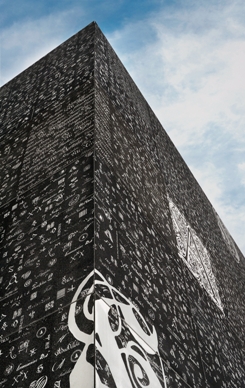
Magazine, Ehitaja, March 2011
Betoon on leidnud tänu oma mitmekülgsetele omadustele ja erinevatele viimistlusvõimalustele laialdast kasutamist ka ehitiste arhitektuuris ning fassaadipindade ilmestamisel. Heaks näiteks on graafiline betoon - uudne viimistlusviis, mille abil on võimalik kanda betooni pinnale väga erinevaid mustreid ja isegi fotosid.
During its long development, concrete has developed into more than just a mixture of cement, water and filler.
Sometimes graphic concrete is also called photobetone.
Unlimited options for creating images
Graphic concrete is a special type of washed concrete. The pattern for decorating the facade is printed with a concrete retarding agent for a special film material using a silk-screen technique.
In the uncovered places of the decalcifying agent, a smooth concrete surface, or shape surface, is visible.
Valikuvõimalus on piiramatu - alates lihtsatest, standardsetest mustritest, lõpetades individuaalsete, spetsiaalselt tellija kavandi või foto põhjal loodud mustritega.
Putting the photo on the concrete is the most complicated
The most difficult of graphic concrete is to apply the photo to concrete.
Different patterns can be used with different-acting retarders, thus achieving a concrete surface with different wash depths.
Looking at the graphic concrete from a distance, we perceive the pattern and the pattern applied to it as a whole, for example, we recognize a photo or image.
Graphic concrete is characterized by a high quality of washbasin concrete. As the retarder is manufactured industrially, the slider layer is very homogeneous and the slider is guaranteed to remain on the film.
Achieving a high-quality result requires accuracy and artist's eye
Achieving high-quality graphic concrete plays an extremely important role in the accuracy of the work and compliance with manufacturing technology.
The washing depth of the washbasin depends to a large extent on the chemical reaction between the concrete and the retarder.
Images that can be applied to the facade can be considerably larger than the dimensions of one element, and the image decorating the building can extend over several elements.
Cooperation between the owner of the building, the architect and the manufacturer is fundamentally important.
Often, graphic concrete is used in close proximity to the sites being observed, often forming a significant part of the building's architecture.
Hämeenlinna County Archives
This is the building that won the 2009 Finnish Concrete Design Award and the Best Concrete Foundation Architecture Award.
The panels were made on the production lines of our Finnish sister company Parma OY. Mikko HeikkineniIt's said that this black "national memory stick" is full of embroidered archival depths from the times of peoples and kings to the signs of today's, Internet era.
Usually the displayed pattern is performed on the laundromat technique and the shape surface remains in the background. This time it was decided to do the opposite. The white symbols on the surface of the concrete are made of a smooth molding surface and the background is a black blanket.
Birth story of graphic concrete
Ornaments have been part of architecture since the beginning of time. There have been seen Valli-Lember Bogatkina and Margareta Fuksi created pannoses.
Graphic Concrete ™ is an interior designer Samuli Naamanka developed and patented technology designed to decorate prefabricated concrete façades.
Graphic Concrete Ltd, a manufacturer of graphite concrete finishing solutions and a manufacturer of slip resistant materials, has actively involved its customers and partners in the development of this technology.
The collaboration between E-Betoonelement and Graphic Concrete Ltd dates back to 2007 when the first test elements were manufactured at Harku.